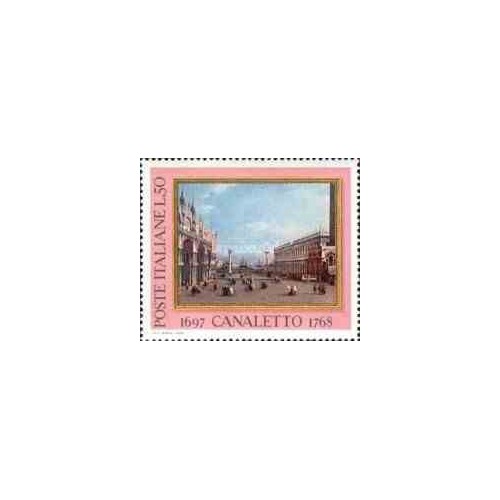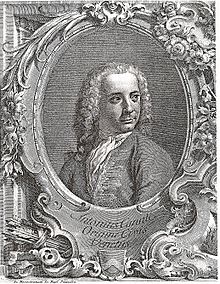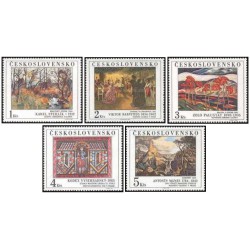- جدید
- ناموجود



توجه : درج کد پستی و شماره تلفن همراه و ثابت جهت ارسال مرسوله الزامیست .
توجه:حداقل ارزش بسته سفارش شده بدون هزینه پستی می بایست 100000 ریال باشد .
توجه : جهت برخورداری از مزایای در نظر گرفته شده برای مشتریان لطفا ثبت نام نمائید.
| Canaletto | |
|---|---|
 |
|
| Born | Giovanni Antonio Canal 28 October 1697 Venice, Republic of Venice |
| Died | 19 April 1768 (aged 70) Venice, Republic of Venice (now Italy) |
| Nationality | Italian |
| Education | Luca Carlevaris |
| Known for | Landscape art, etching |
| Patron(s) | Owen Swiny Joseph Smith |
Giovanni Antonio Canal (28 October 1697 – 19 April 1768),[1] better known as Canaletto (Italian: [kanaˈletto]), was an Italian painter of landscapes, or vedute, of Venice. He was also an important printmaker in etching. He was the son of the painter Bernardo Canal, he visited England between 1746–56 and he is famous for his urban landscapes of Venice.[2] He is very famous for his scenes, usually associated with "evocative views of the city".[3] The Stonemason´s Yard, was his finest work around 1725 and was presented by Sir George Beaumont in 1823/8.[4]
Canaletto, together with Giambattista Pittoni, Giovan Battista Tiepolo, Giovan Battista Piazzetta, Giuseppe Maria Crespi and Francesco Guardi forms the ultimate group of Venetian old master painters.


He was born in Venice as the son of the painter Bernardo Canal, hence his mononym Canaletto ("little Canal"), and Artemisia Barbieri.[5] Canaletto served his apprenticeship with his father and his brother. He began in his father's occupation, that of a theatrical scene painter. Canaletto was inspired by the Roman vedutista Giovanni Paolo Pannini, and started painting the daily life of the city and its people.

After returning from Rome in 1719, he began painting in his topographical style.[6] His first known signed and dated work is Architectural Capriccio (1723, Milan, in a private collection).[1] Studying with the older Luca Carlevarijs, a moderately-talented painter of urban cityscapes,[6][7] he rapidly became his master's equal.
In 1725, the painter Alessandro Marchesini, who was also the buyer for the Lucchese art collector Stefano Conti, had inquired about buying two more 'views of Venice', when the agent urged him to consider instead the work of "Antonio Canale... it is like Carlevaris, but you can see the sun shining in it."[8]

Much of Canaletto's early artwork was painted "from nature", differing from the then customary practice of completing paintings in the studio. Some of his later works do revert to this custom, as suggested by the tendency for distant figures to be painted as blobs of colour – an effect produced by using a camera obscura, which blurs farther-away objects.
However, his paintings are always notable for their accuracy: he recorded the seasonal submerging of Venice in water and ice.[9]

Canaletto's early works remain his most coveted and, according to many authorities, his best. One of his early pieces is The Stonemason's Yard (1729, London, the National Gallery) which depicts a humble working area of the city.
Later Canaletto painted grand scenes of the canals of Venice and the Doge's Palace. His large-scale landscapes portrayed the city's pageantry and waning traditions, making innovative use of atmospheric effects and strong local colors. For these qualities, his works may be said to have anticipated Impressionism.
His graphic print S.A Giustina in Prà della Vale was found in the 2012 Nazi loot discovery.[10]

Many of his pictures were sold to Englishmen on their Grand Tour, often through the agency of the merchant Joseph Smith (who was later appointed British Consul in Venice in 1744).
It was Smith who acted as an agent for Canaletto, first in requesting paintings of Venice from the painter in the early 1720s and helping him to sell his paintings to other Englishmen.[11]
In the 1740s Canaletto's market was disrupted when the War of the Austrian Succession led to a reduction in the number of British visitors to Venice.[12] Smith also arranged for the publication of a series of etchings of "capricci" (or architectural phantasies) (capriccio Italian for fancy) in his vedute ideale,[7] but the returns were not high enough, and in 1746 Canaletto moved to London, to be closer to his market.[6]

He remained in England until 1755, producing views of London (including several of the new Westminster Bridge, which was completed during his stay) and of his patrons' castles and houses. His 1754 painting of Old Walton Bridge includes an image of Canaletto himself.

He was often expected to paint England in the fashion with which he had painted his native city. Canaletto's painting began to suffer from repetitiveness, losing its fluidity, and becoming mechanical to the point that the English art critic George Vertue suggested that the man painting under the name 'Canaletto' was an impostor.[citation needed]
The artist was compelled to give public painting demonstrations in order to refute this claim; however, his reputation never fully recovered in his lifetime.[13]
After his return to Venice, Canaletto was elected to the Venetian Academy in 1763 and appointed prior of the Collegio dei Pittori. He continued to paint until his death in 1768. In his later years he often worked from old sketches, but he sometimes produced surprising new compositions. He was willing to make subtle alternations to topography for artistic effect.[7]

His pupils included his nephew Bernardo Bellotto, Francesco Guardi, Michele Marieschi, Gabriele Bella, and Giuseppe Moretti. The painter, Giuseppe Bernardino Bison was a follower of his style.[9]
Joseph Smith sold much of his collection to George III, creating the bulk of the large collection of works by Canaletto owned by the Royal Collection. in 1762, George III paid £20,000 for Consul Smith's collection of 50 paintings and 142 drawings.[14] There are many examples of his work in other British collections, including several (19) at the Wallace Collection and a set of 24 in the dining room at Woburn Abbey. A large set of Canaletto works was also part of the collection of the Earls of Carlisle, however many were lost at the 1940 fire of Castle Howard and others were sold over the last century. Among those formerly at the Carlisle collection are "The Bacino di San Marco: looking East", now at the Museum of Fine Arts, Boston (sold in 1939) and the pair "Entrance to the Grand Canal from the Molo, Venice" and "The Square of Saint Mark's, Venice", now at the National Gallery of Art, Washington DC (sold in 1938). The last important venetian veduta at Castle Howard was by Bernardo Bellotto, "A View of the Grand Canal Looking South from the Palazzo Foscari", which was sold at Sotheby's in July 2015 for £2.6 million.
Canaletto's views always fetched high prices, and as early as the 18th century Catherine the Great and other European monarchs vied for his grandest paintings. The record price paid at auction for a Canaletto is £18.6 million for View of the Grand Canal from Palazzo Balbi to the Rialto, set at Sotheby's in London in July 2005.
تشکر نظر شما نمی تواند ارسال شود
گزارش کردن نظر
گزارش ارسال شد
گزارش شما نمی تواند ارسال شود
بررسی خود را بنویسید
نظر ارسال شد
نظر شما نمی تواند ارسال شود

check_circle
check_circle


















